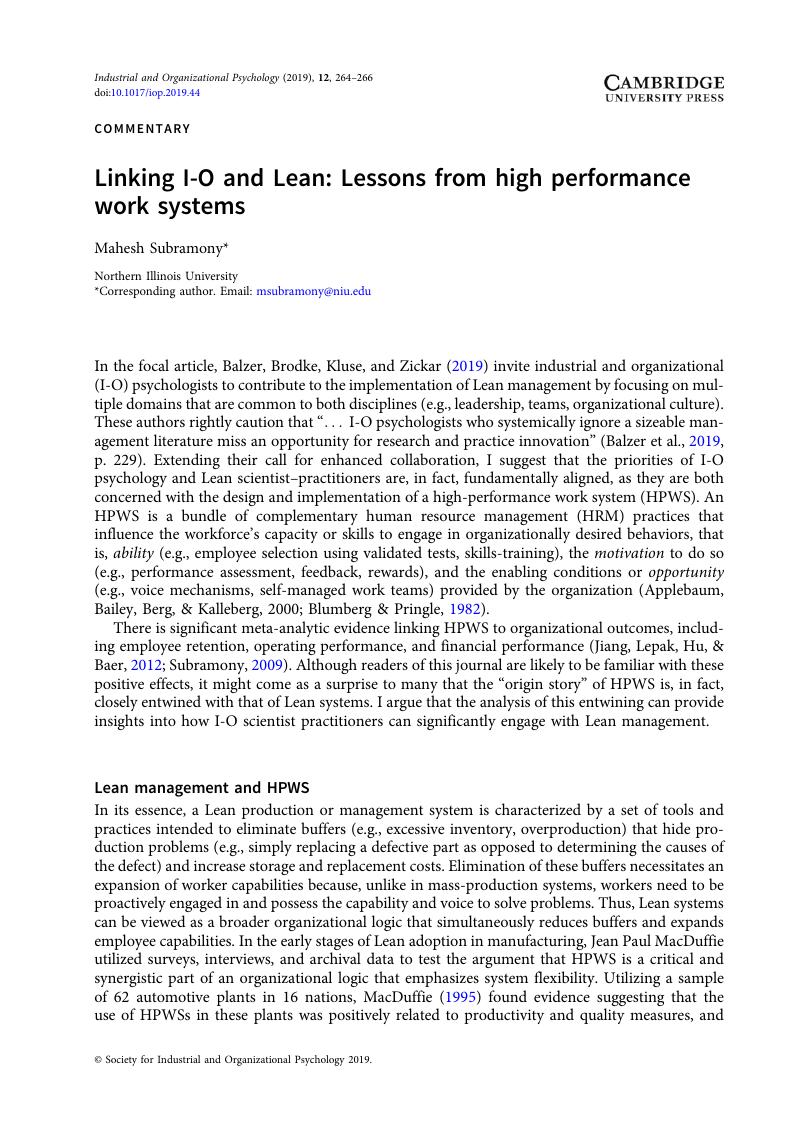No CrossRef data available.
Article contents
Linking I-O and Lean: Lessons from high performance work systems
Published online by Cambridge University Press: 13 November 2019
Abstract
An abstract is not available for this content so a preview has been provided. Please use the Get access link above for information on how to access this content.

- Type
- Commentaries
- Information
- Copyright
- © Society for Industrial and Organizational Psychology 2019
References
Appelbaum, E., Bailey, T., Berg, P., & Kalleberg, A. L. (2000). Manufacturing advantage: Why high performance work systems pay off. Ithaca, NY: Cornell University Press.Google Scholar
Balzer, W. K., Brodke, M. H., Kluse, C., & Zickar, M. J. (2019). Revolution or 30-year fad? A role for I-O psychology in Lean management. Industrial and Organizational Psychology: Perspectives on Science and Practice, 12(3), 215–233.Google Scholar
Barney, J., & Felin, T. (2013). What are microfoundations? Academy of Management Perspectives, 27, 138–155.CrossRefGoogle Scholar
Blumberg, M., & Pringle, C. D. (1982). The missing opportunity in organizational research: Some implications for a theory of work performance. Academy of Management Review, 7, 560–569.CrossRefGoogle Scholar
Boselie, P., Dietz, G., & Boone, C. (2005). Commonalities and contradictions in HRM and performance research. Human Resource Management Journal, 15(3), 67–94.CrossRefGoogle Scholar
Huselid, M. A. (1995). The impact of human resource management practices on turnover, productivity, and corporate financial performance. Academy of Management Journal, 38, 635–672.Google Scholar
Huselid, M. A., & Becker, B. E. (2011). Bridging micro and macro domains: Workforce differentiation and strategic human resource management. Journal of Management, 37, 421–428.CrossRefGoogle Scholar
Jiang, K., Lepak, D., Hu, J., & Baer, J.C. (2012). How does human resource management influence organizational outcomes? A meta-analytic investigation of mediating mechanisms. Academy of Management Journal, 55, 1264–1294.CrossRefGoogle Scholar
MacDuffie, J. (1995). Human resource bundles and manufacturing performance: Organizational logic and flexible production systems in the world auto industry. Industrial and Labor Relations Review, 48, 197–221.CrossRefGoogle Scholar
Subramony, M. (2009). A meta-analytic investigation of the relationship between HRM bundles and firm performance. Human Resource Management, 48, 745–768.CrossRefGoogle Scholar


